
The Northwest Territories is a federal territory of Canada. At a land area of approximately 1,127,711.92 km2 (435,412.01 sq mi) and a 2021 census population of 41,070, it is the second-largest and the most populous of the three territories in Northern Canada. Its estimated population as of the second quarter of 2024 is 44,920. Yellowknife is the capital, most populous community, and only city in the territory; its population was 20,340 as of the 2021 census. It became the territorial capital in 1967, following recommendations by the Carrothers Commission.
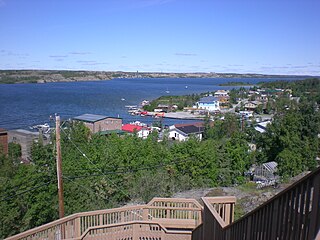
Yellowknife is the capital, largest community, and only city in the Northwest Territories, Canada. It is on the northern shore of Great Slave Lake, about 400 km (250 mi) south of the Arctic Circle, on the west side of Yellowknife Bay near the outlet of the Yellowknife River.
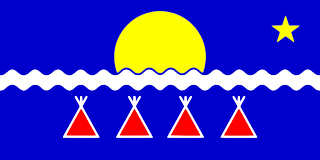
The Tłı̨chǫ people, sometimes spelled Tlicho and also known as the Dogrib, are a Dene First Nations people of the Athabaskan-speaking ethnolinguistic group living in the Northwest Territories of Canada.

The Argyle Diamond Mine was a diamond mine located in the East Kimberley region in the remote north of Western Australia. Argyle was at times the largest diamond producer in the world by volume, although the proportion of gem-quality diamonds was low. It was the only known significant source of pink and red diamonds, and additionally provided a large proportion of other naturally coloured diamonds, including champagne, cognac and rare blue diamonds.

The Ekati Diamond Mine, often simply called Ekati, is Canada's first surface and underground diamond mine and is owned by Burgundy Diamond Mines. It is located 310 km (190 mi) north-east of Yellowknife, Northwest Territories, and about 200 km (120 mi) south of the Arctic Circle, near Lac de Gras. Until 2014, Ekati was a joint venture between Dominion Diamond Mines (80%), Chuck Fipke, and Stewart Blusson, the two geologists who discovered kimberlite pipes north of Lac de Gras. Fipke and Blusson each held 10% stake in the mine, until Fipke sold his share to Dominion. In 2021, Arctic Canadian Diamond Company Ltd. acquired the Ekati Diamond Mine with associated assets and liabilities from Dominion Diamond Mines. In July 2023, Burgundy Diamond Mines purchased full control of Arctic Canadian Diamond Company.

The Diavik Diamond Mine is a diamond mine in the North Slave Region of the Northwest Territories, Canada, about 300 km (190 mi) northeast of Yellowknife.
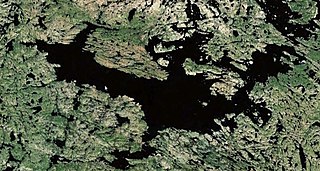
Lac de Gras is a lake approximately 300 kilometres (190 mi) north east of Yellowknife, in the Northwest Territories of Canada. Lac de Gras was the centre of the diamond rush of the 1990s. There are two working, and one closed, diamond mines in the area, Diavik Diamond Mine, Ekati Diamond Mine, and the care and maintenance Snap Lake Diamond Mine. It was called Ekati by aboriginal peoples.

The Jericho Diamond Mine is a dormant diamond mine located in Canada's Nunavut territory. Jericho is Nunavut’s first and only diamond mine. It is located 420 km (260 mi) northeast of Yellowknife, Northwest Territories and is accessible by air all year and by winter road from Yellowknife. The project was mined from 2006 to 2008, and produced 780,000 carats of diamonds from 1,200,000 tonnes of kimberlite mined from the open pit operation. Over $200 million was invested in the development of the Jericho operations including the construction of a 2,000 t per day diamond recovery plant, maintenance facility, fuel farm, and offices and accommodation for 225 personnel.

A diamond rush is a period of feverish migration of workers to an area where diamonds were newly discovered. Major diamond rushes took place in the late 19th and early 20th centuries in South Africa and South-West Africa.
Stewart Lynn "Stu" Blusson, is a Canadian businessman, geologist, investor, philanthropist, and prospector. He co-discovered the billion-dollar Ekati Diamond Mine, 300 kilometres from Yellowknife, Northwest Territories, Canada. He serves as President of Archon Minerals Ltd. In 2002, Blusson donated key start-up funds necessary for Quest University Canada in Squamish, British Columbia. In 2006, Blusson donated $10 million for the Archon X PRIZE to develop a quick and inexpensive way to sequence the human genome. Blusson had a net worth of $660 million CDN in 2006.
The Gahcho Kué Diamond Mine is located on the Canadian tundra in the Northwest Territories. It is situated at Kennady Lake, in the Akaitcho Treaty 8 Territory claim block, which is 85 km (53 mi) southeast of the Snap Lake Diamond Mine and approximately 280 km (170 mi) east northeast of Yellowknife. The site is served by Gahcho Kue Aerodrome, which has both an ice runway in winter and a year-round gravel runway, and a spur of the Tibbitt to Contwoyto Winter Road from Lupin Mine. the main camp is at 63°26′05″N109°12′02″W, north of the ice strip, with a smaller site at 63°25′48″N109°12′00″W, south of the runway.
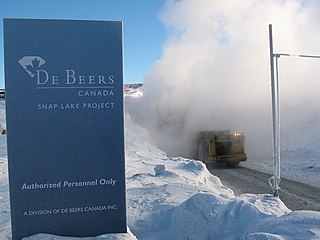
Snap Lake Mine was a remote fly-in/fly-out operation located about 220 km (140 mi) northeast of Yellowknife, Northwest Territories, and, according to De Beers, was the first De Beers mine outside of Africa. It was also Canada's first completely underground diamond mine.

Tibbitt to Contwoyto Winter Road is an annual ice road first built in 1982 to service mines and exploration activities in the Northwest Territories and Nunavut in Northern Canada. Between 400 and 600 km long, the road is said to be the world's longest heavy haul ice road and operates for eight to ten weeks starting in the last week of January. Most of the road (85%–87%) is built over frozen lakes, 495 km (308 mi), with the remaining 73 km (45 mi) built on over 64 land portages between lakes.
The Gahcho Kué kimberlite pipes is a cluster of Cambrian kimberlite diatremes located 280 km (174 mi) northeast of Yellowknife, Northwest Territories, Canada. It consists of five pipes: 5034, Hearne, Wilson, Tuzo and Tesla.

The Lac de Gras kimberlite field is a group of Late Cretaceous to Eocene age diatremes in the Northwest Territories, Canada.
This timeline of Yellowknife history summarises key events in the history of Yellowknife, a city in the Northwest Territories, Canada.
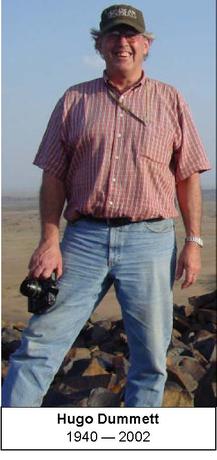
Hugo T. Dummett (1940–2002) was a South African mineral-exploration geologist who is best known for his role in the discovery of the Ekati Diamond Mine in the Barren Lands of Canada's Northwest Territories. Dummett has been described as "the brains, the ideas and the energy" behind the discovery of Ekati, which led to the creation of a new Canadian diamond-mining industry.
The Bathurst Inlet Port and Road Project is a plan to build an all-weather road from Bathurst Inlet in Nunavut to a complex of mines that are approximately equidistant between Bathurst Inlet and Yellowknife, NWT. There are no paved roads between Yellowknife and the mines, so they have relied on shipping supplies to the mines over winter-time ice roads. However, in 2005, there was a particularly warm winter, and the ice roads weren't safe for a long enough period to bring in supplies.














